
Great content is one of the most effective ways to drive business growth.
It’s also hard.
There are moments when you’re chock-full of motivation. Ideas leap out of your mind and straight onto the page.
Other times, you might spend hours trying to come up with a good idea, much less write your first sentence.
It happens to all of us.
However, blog posts are still the top asset to engage with your audience and generate leads for your business.
In fact, 82 percent of companies actively use content marketing to grow their business.
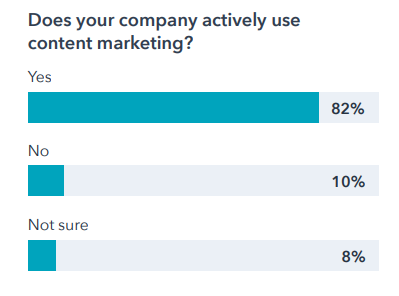
So what’s the one tool that can allow you to pack more power into each blog post so that generating leads isn’t like climbing a mountain?
Persuasion.
A persuasive blog post not only gets the conversation started, but it creates an appetite for your ideas and products, without you coming across like a sleazy salesman.
This is why I put so much time, money, and effort into creating exceptional content with all the persuasive checks and balances.
I’ve mentioned this before: When I started blogging, my content failed to hit the mark.
Now, I have a fine-tuned system that allows me to create powerful content in record time.
You can do it, too.
In this post, I’ll give you the specific formula I use to craft quality blog posts in under an hour.
Step #1: Create A Bank of Content Ideas
Truthfully, I have a difficult time coming up with great ideas — which is why I developed a process to get my creative juices flowing.
When you can’t think of what to write about, there are four simple ways you can come up with viral-worthy blog topics.
First, create a master spreadsheet to serve as your idea bank. The headings should look something like this:

Now, it’s time to add ideas to your spreadsheet. Here’s how to come up with them.
Analyze Your Products and Services
While blogging isn’t a direct sales tool, you do want to be intentional about choosing topics that are aligned with what your business offers.
This way you’re not blogging for the sake of blogging and are more likely to see a return on your time investment.
Consider each offer individually, and ask these questions.
What hurdles are preventing your prospects from saying yes?
Addressing the objections people have about your business is the best way to improve your lead generation efforts.
A gold mine for finding these objections is on webinar chat boxes. You can either examine your own webinars or those of your competitors.
You’ll find a scenario like this:

More questions to use when considering your products/services:
- Why are you the best person to solve their problems?
- Why not your competitor?
- What’s the urgency?
- Why is your product relevant now?
- Why is your product the #1 solution?
Use these questions to brainstorm, and add the answers to your spreadsheet. You can then use the headline formula I provide later to create a custom headline.
Audit Your Popular Blog Content
The best way to know what content will delight your audience is to pinpoint blog posts that already hit the mark.
Check your analytics and note the categories of the most popular posts and content upgrades.
You can also use Ubersuggest to find your most popular content. Here’s how:
Navigate to Ubersuggest, enter your URL, and click search.

From there, navigate to the left sidebar. Click on “Top Pages” under the “Traffic Analyzer” section.
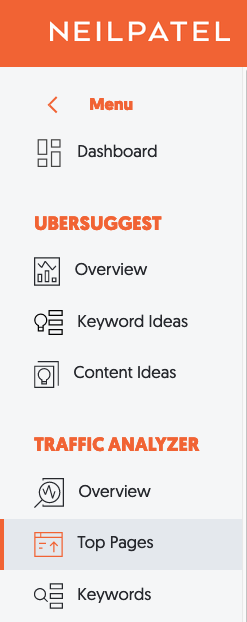
Finally, analyze your results to better understand which pages of your website are attracting the most visitors.
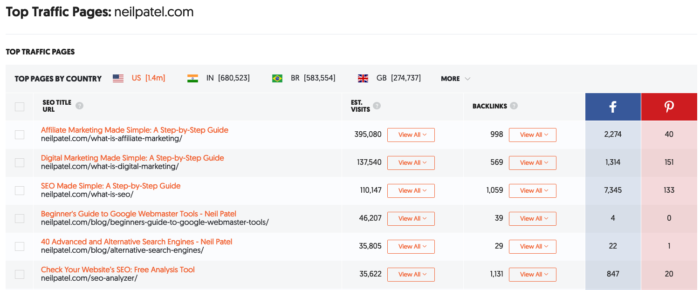
The screenshot above displays your top traffic pages, in order, along with other data such as:
- estimated visits per month
- number of backlinks to the page
- number of social shares on Facebook and Pinterest
A quick review of the top results shows that my audience is most interested in affiliate marketing, SEO, and content marketing.
Now that you know this, you have a better idea of where to focus your content creation efforts in the future.
Conduct a Competitive Analysis
I believe in making your competitors work for you and not against you — and one way to do this is to look at what is working for them.
I’m not saying copy their strategy. Rather, look at what content is ranking well and look for ways you can do it better.
Can you cover a different angle? Add more research? Maybe include downloads that make your content more useful.
You can also use Ubersuggest for this.
Simply plug in your keyword and click search.
From there, click on “Content Ideas” in the left sidebar. Here’s what you end up with.

The goal is to find the most popular content for your keyword. Do this by focusing on the number of backlinks to the URL and the number of social shares.
For example, the first listing when searching for “blogging is Passive Income Blogging: How to Make $1051 with an Amazon Affiliate Blog in a Month.
Not only does it have more than 100 backlinks, but it’s been shared on Facebook and Pinterest more than 13,000 times. This proves that it’s popular among your target audience.
Make it yours, make it better, and readers will find you.
Look At Customer Pain Points
It amazes me how many people neglect this step.
You want to tell an effective story, create hyper-relevant content, and be perceived as an authority.
Ignoring the people you’re trying to reach is not the best way to accomplish this.
It’s to get into the heads and hearts of your audience. Here’s where you can get that insight:
- blog comments
- Quora
- niche Forums
- Amazon book reviews (pay special attention to the negative reviews)
- Facebook groups
- Twitter search
- your own site search
What questions are your prospects asking? What objections do they have? What do they need help with?
Take down these ideas word for word. The goal at this point is not to form a concrete hook but to generate ideas.
Ask Your Customer Service Reps
If you have a customer service team, now is the time to loop them in. What questions do they get asked the most? What pain points do they hear about?
Is there an area in your own solution that causes issues?
Gather those ideas and see if there’s a way to make a blog post. At the very least, you might come up with some good Frequently Asked Questions to add to your post.
Don’t have a customer service team?
Check out your chatbot or email support inbox. I’m sure there are a few diamonds in the rough you can use to create compelling content.
After you’ve completed these five steps, you’ll have an arsenal of raw data that can be transformed into custom blog topics.
Step #2: Gather Sources & Get Started on Research
What if I told you that writing a blog post is just like carving a sculpture?
You are the artist. Your research document is your block of marble. You just need to chisel away at the unnecessary material to give life to your post.
The only question that remains is how do you conduct research fast?
The process is quite simple:
- The same steps used to generate blog topics can be used for your research. Instead of focusing on the idea, you focus on the content.
- As you read to gather your research, jot down the ideas that come to mind. Let reading be the input and writing the output.
- The goal is to create a valuable, data-driven post. Use the following sources to gather your data:
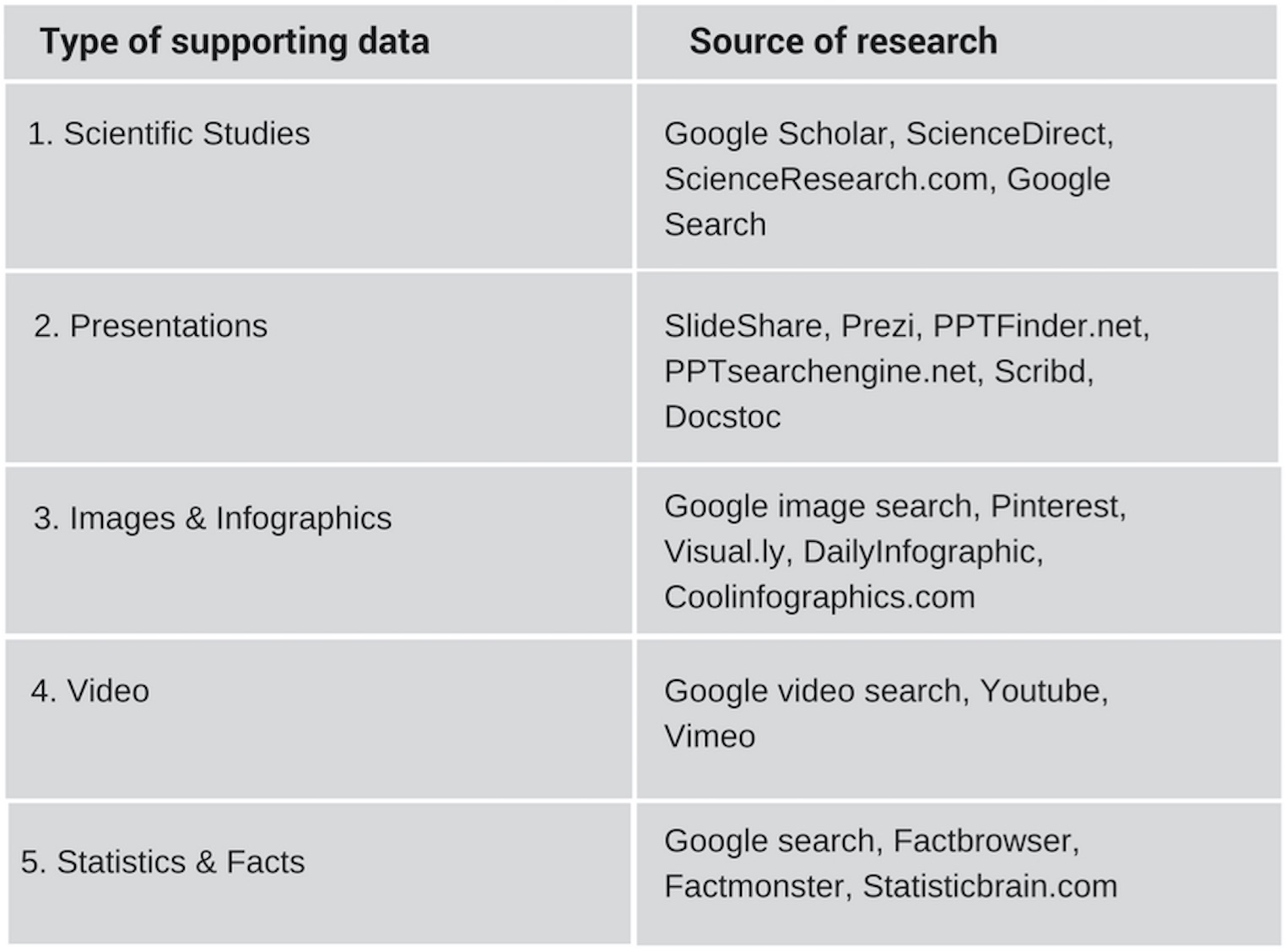
After you’ve done your research, let it sit.
When I let my ideas marinate overnight they become more refined, I gain more clarity, and the direction of my post becomes concrete in my mind.
Here’s another pro-tip to save you time — save the best research results in a bookmark or Google Doc. Next time you need research, you’ll be able to find it right away, rather than having to sift through the search results again!
So how do you know what to chisel away in order to sculpt your blog post? It’s all in the framework.
Step #3: The 6-Point Framework of a Persuasive Blog Post (Plus an Outline You Can Steal)
There are few things in the world that people hate more than being marketed to when they just want information.
If your readers detect even a hint of sleaze in your blog posts, they will make a dive for the exit button.
The only way to escape that unfortunate fate is to stop selling and start persuading.
There are six pressure points that you need to tap into:

1. Likeability: If your readers don’t like you, everything else is irrelevant. Naturally, people are skeptical of perfection. So be vulnerable, tell your story, and document the imperfections. Eighty-six percent of consumers say authenticity is important when choosing a brand to do business with.
2. Credibility: Your readers not only need to believe in you, but they need to believe in their own ability to produce results. That’s where providing easily consumable and actionable content comes into play. A great way to create more bite-sized content is to add images every 100 words or so. In fact, images can boost content credibility by 75 percent.

3. Urgency: You need to help your readers get over their tendency to procrastinate. The way to do that is to emphasize the urgency.
Why does the information in your blog post matter today? A genius way to insert call-to-action in your post is to create content upgrades. Backlinko improved their conversion rates by 785 percent (in one day!) using this method.

4. Authority: Your authority is increased by creating comprehensive, data-driven content with unique insights. The more authority you command, the more people will bet on you to deliver the transformation that they seek.
5. Reciprocity: Attention is currency in the online space. So when someone gives you their attention, you reciprocate by providing value with no strings attached. In fact, giving away your best content for free can help you reap big rewards.
6. Authenticity: Who is ever their absolute authentic self in every scenario? Seth Godin describes authenticity as consistency. It means showing up day after day with a congruent message.
If you’re shaky with your ideas or complacent about the way that you express them, you won’t hold up to scrutiny. A study of 27,000 consumers revealed that consistency is critical for trust and loyalty.
I know this sounds like a lot of criteria for one blog post to meet.
To do it all in 45 minutes? Impossible.
Not at all.
I’ve created a simple outline that satisfies every point of this framework.
I challenge you to use it and see your writing skills improve by leaps.
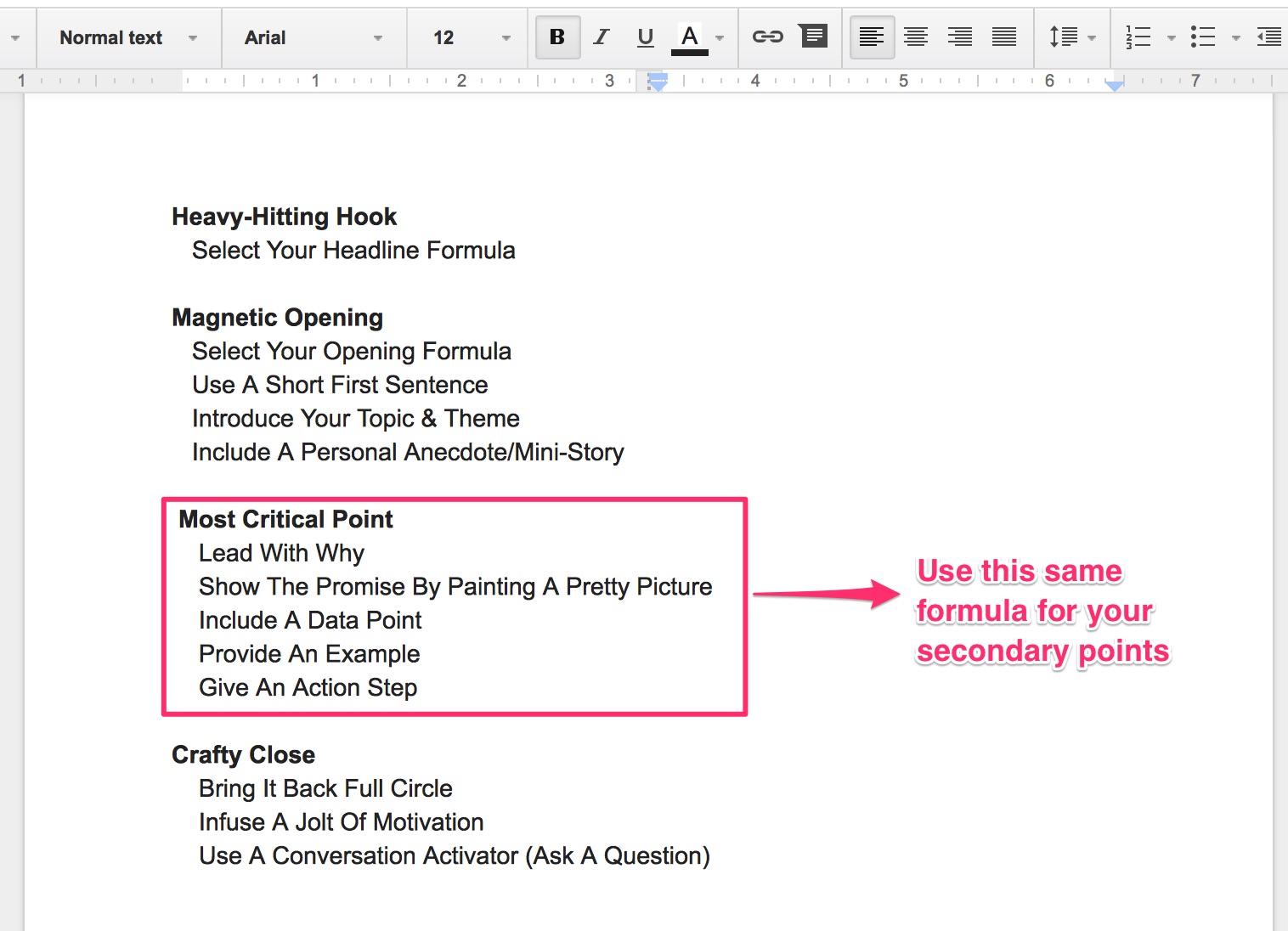
Step #4: Flesh Out Your Outline In Record Time
Now it’s time to execute.
By this point, you should have come up with a stockpile of blog topics.
You’ve filled your research document and now it’s time to create your outline without wasting any time.
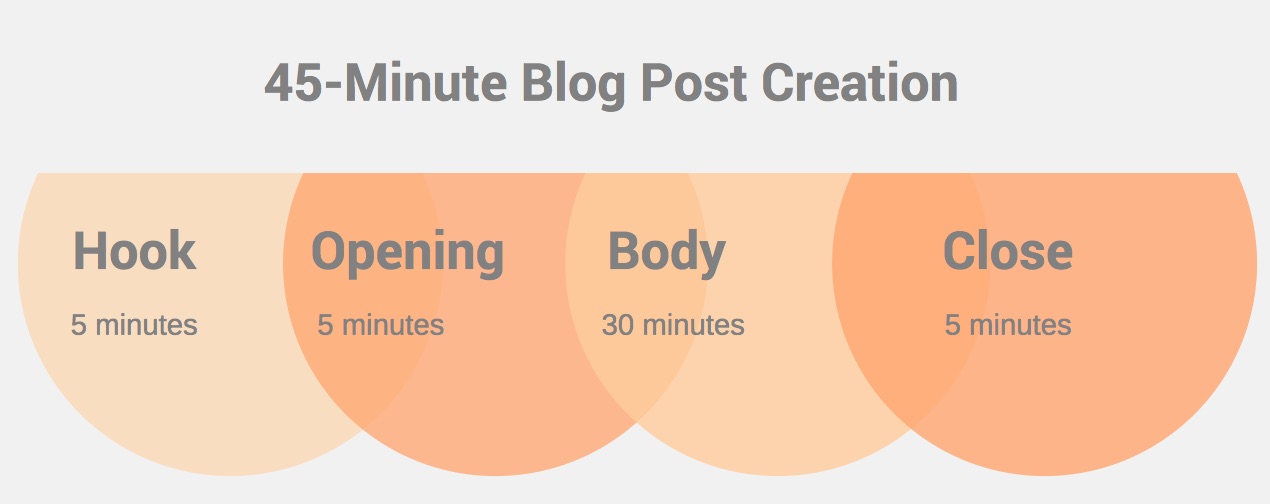
I suggest putting on some concentration music and diving into the outline. I also use a digital timer to keep myself from getting pulled down rabbit holes. Sure, you could spend two hours researching — but you’ll create better content if you can stay focused.
Ready to create your outline? Here’s how to get started
Craft a Heavy-Hitting Hook (5 Minutes)
A crappy headline is the kiss of death.
You might as well beg people to go read any one of the other millions of blog posts that are published every day.
Here’s how to ensure that your headline delivers a solid punch:
Rule #1: Be super-specific. Use numbers in your headline and avoid ambiguous words like amazing, awesome, and great. There are other lackluster words that put readers to sleep, but these are the likely culprits.
Rule #2: Flirt, don’t reveal your total solution. If you uncover your solution right away, there’s no incentive to keep reading. Be mindful that there is a fine line between a curiosity-infused headline and desperate clickbait.
Rule #3: Invoke an emotional response. This Harvard study shows we make decisions on an emotional basis and only appeal to logic to justify these decisions.
By now, you already know that great ideas aren’t formulaic, but the vessel in which they are contained is.
Your headline is that vessel.
Here are 11 proven headline formulas that work:
1. Breaking News Headline
Formula: [Story] + [Effect]
Example: New Google Algorithm Gives Top Blogs A Heavy Blow
2. The List Headline
Formula: [Number] of Ways To [Desired Outcome]
Example: 127 Ways To Market Your Online Course
3. The Burning Question
Formula: [Pose A Provocative Question]
Example: Is The Money Really In The List?
4. A Fun Juxtaposition
Formula: [Present two conflicting ideas or positions]
Example: How to Be Smart in a World of Dumb Bloggers (From SmartBlogger)
5. The How-To Headline
Formula #1: How To [Method] To [Achieve Desired Outcome] Like [Gripping Simile/Metaphor]
Example: How To Use Content Upgrades to Grow Your Email List Like Wildfire
Formula #2: How To [Method] To [Achieve Desired Outcome] In [Specific Timeframe]
Example: How To Use Persuasion To Write Blockbuster Blog Posts in 45 Minutes
6. The Ultimate Guide
Formula: The [Ultimate/Complete] Guide To [Total Transformation]
Example: The Ultimate Guide To Content Marketing
7. The Name Dropper
Formula: [Famous Person] [Method, Advice, Tips] For [Achieving A Desired Outcome]
Example: Stephen King’s 20 Tips for Becoming a Frighteningly Good Writer (From SmartBlogger)
8. Introduce The Evil Villain
Formula: [Evil Villain] That [Specific Misdeed]
Example: The 10 Types Of Pseudo-Experts That Are Robbing You Blind
9. Address A Resident Emotion
Formula: [Appeal To A Fear/Other Strong Emotion]
Example: An Open Letter To Entrepreneurs Struggling To Make A Profit
10. The Mistakes, Errors, Warnings
Formula: [Number] Mistakes People Make [Specific Action]
Example: 12 Fatal Sales Copywriting Mistakes
11. Leading With Why Headline
Formula: [Why] [Specific Thing] [Outcome/Adjective]
Example: Why Creativity Is Overrated
Write A Magnetic Opening (5 minutes)
Your lead serves as the gateway to the rest of your post so you want it to be inviting, entertaining, and full of promise.
Some rules for writing a hypnotic blog post opening:
Rule #1: Keep your first sentence short, snappy, and snackable. Short sentences boost content readability.
Rule #2: Aggravate the problem and use emotive language to paint a picture of your big promise. Here are 801 power words that you can use to create an emotionally gripping narrative.
Rule #3:Use personal anecdotes and mini stories to boost your credibility and authenticity factors.
Want formulas? Here are 9 power hitters:
- The Quote Lead: Use a quote relevant to your blog post. Your readers should be able to recognize the author of your quote so it’s best to use an influencer in your niche.
- The Impending Danger Lead: This is where you introduce an evil villain and lean strongly on emotion.
- The Counterintuitive Lead: Open by presenting a solution which goes against the grain.
- The Empath Lead: Let readers know that you understand how they feel, you’ve walked in their shoes, and that they’re not alone.
- The Shock Value Lead: Open with an unexpected fact.
- The Storytelling Lead: An intriguing tale goes a long way to draw readers in. It could be true or metaphorical, as long as it’s within the context of your blog post.
- The “Get Right To It” Lead: The no fluff, “I won’t waste your time” lead. You have to establish the premise of your post right away.
- The “Call Out” Lead: Have the audacity to call your reader out. Do they have a bad habit that’s keeping them in the dark? What are they complacent about?
- Pop Quiz Lead: Open by providing a list of options and set it up where there can only be two or three outcomes.
Here’s an example:

One quick tip — make sure to use your target key term in the first 300 words. This indicates to Google (and your readers) what the topic is about and can help you rank higher in SERPs.
I used to go really heavy on narrative intros, but recent Google updates have made this less effective. So be interesting, but not long winded.
Step #5: Pack Your Post With Value (30 minutes)
Naturally, this is where you’ll invest the most time.
If you take your time in the research phase, it’s a matter of chipping away at the unnecessary information and tightening up your post.
Here’s the blueprint for shaping each point in your body:

Some quick tips for writing dynamic body content:
Tip #1: Strike the right balance between emotion and ration. Hitting the emotional hot buttons is critical but your readers have a need for logic, particularly if they’re being promised something sensational.
Tip #2: Readers should be able to easily implement your solutions themselves and see an immediate benefit or result. This is going to amplify your perceived value and keep people coming back, day after day.
Tip #3: Let your personality show up. Your unique writing voice will take time to develop, but here’s what you can do to accelerate the process:
- Brainstorm two words that describe your personality. Find words and phrases that are synonymous or associated with these two keywords. Let that serve as your swipe file of personality power words and use them in your writing.
- Create an imaginary reader, name them, and write like you’re having a conversation with that ONE person.
Bonus Time Saving Tip: Use a voice typing tool so you don’t have to physically type. Simply dictate your points and most voice typing tools will spell out the words with remarkable accuracy.
Step #6: Write A Solid Close And CTA (5 Minutes)
Take a minute to analyze a few of your blog posts.
Do you notice a specific pattern in how you close your posts? I bet you do.
That’s because when we do a task over and over, we subconsciously develop a mental protocol to save time and effort.
You may have noticed, I always headline my close as “Conclusion” plus the target keyword. I always pose a question as the final interaction, and I always end with a positive outlook.
You don’t have to use this same structure, but it works well — which is why I keep doing it.
While there are no rules, there are some tips and tricks for closing effectively:
Tip #1: Emphasise the main message. You don’t want your blog post to be linear or incomplete. Did you lead with a mini story about Mark? Make sure Mark shows up in your closing. Did you lean on a particular emotion in your opening? Call that emotion to action in your close.
Tip #2: Give readers a reason to act with urgency. What’s the big benefit? What’s the ultimate promise? Remind them so they’ll be inclined to act on your solutions.
Tip #3: Positivity and optimism will trump fear any day. Be inspiring. Be motivational. Be a cheerleader.
Tip #4: End with a conversation starter. Asking a question at the end gives readers a nudge to engage and comment on your post.
Frequently Asked Questions: Write An Amazing Blog Post Fast
What is the key to writing a blog post fast?
Creating a repeatable process, like the one I outline in this post. Creating a process keeps you moving forward and prevents you from getting bogged down in the details. I also recommend using a timer to keep yourself on track.
How long should it take to write a blog post?
If you use my process, you can create high-quality blog posts in around 45 minutes, including research and writing. It’s all about creating a solid outline and staying focused.
What tools can I use to write blog posts faster?
Use Ubersuggest to research topics, find ideas, and perform a competitive analysis. A voice to text tool can help you write faster. I also suggest a digital timer to keep yourself focused.
How long of a blog post can I write in under 60 minutes?
Using the process above, you can easily create 1500 to 2000 word posts in less than an hour.
Conclusion: How to Write an Amazing Blog Post in Under 60 Minutes
Even if you’re a self-proclaimed terrible writer who spends weeks writing and editing one blog post , you can create a persuasive powerhouse of a blog post without consuming days of your time.
This is not to say your first blog post will take 60 minutes — it probably won’t. However, over time this process will become second nature and you’ll find you can crank out a high-ranking blog post in less than an hour.
I’m proof it doesn’t require any form of wizardry or extraordinary talent. What it takes is commitment and trust in the systems proven to generate results.
There will be moments when the process gets grueling, but when your traffic and conversions go up, you’ll know it was worth the effort.
What’s your process for writing quality blog posts quickly? Do you have any tips and tricks that I didn’t mention in this post?
from Blog – Neil Patel https://ift.tt/2rYlFP3

No comments:
Post a Comment